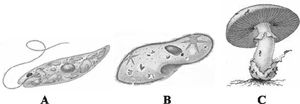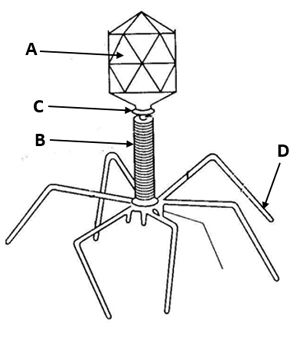Match column I (containing fungus name) with column II (common name) and choose the correct options.
| Column-I | Column-II |
|---|---|
| (Fungus name) | (Commonly called) |
| A. Puccinia | I. Yeast |
| B. Ustilago | II. Mushroom |
| C. Agaricus | III. Smut fungus |
| D. Saccharomyces | IV. Rust fungus |
A I, B II, C III, D IV
A II, B III, C IV, D I
A III, B IV, C I, D II
A IV, B III, C II, D I
Correct Answer :
D. A IV, B III, C II, D I
Puccinia, Ustilago, Agaricus and Saccharomyces are commonly called as rust fungi, smut fungi, mushroom and yeast respectively.
Related Questions
In some viruses, RNA is present instead of DNA indicating that
their nucleic acid must combine with host DNA before replication.
they cannot replicate.
there is no hereditary information.
RNA can transfer heredity material.
Which one of the following statement is correct for archaea?
Archaea resemble eukaryotes in all respects.
Archaea have some novel features that are absent in other prokaryotes and eukaryotes.
Archaea completely differ from both prokaryotes and eukaryotes.
Archaea completely differ from prokaryotes.
Match column I with column II and choose the correct option.
| Column I | Column II |
|---|---|
| A. Mycoplasma | (i) Nitrogen fixing cells |
| B. Decomposers | (ii) Blue green algae |
| C. Methanogens | (iii) Production of methane |
| D. Heterocysts | (iv) Most abundant heterotrophs |
| E. Cyanobacteria | (v) Pathogenic in plants and animals |
A-(i) B-(ii) C-(iii) D-(iv) E-(v)
A-(iii) B-(v) C-(ii) D-(iv) E-(i)
A-(iii) B-(i) C-(v) D-(ii) E-(iv)
A-(v) B-(iv) C-(iii) D-(i) E-(ii)
Match the scientists given in column I with their discovery given in column II and choose the correct option.
| Column-I | Column-II |
|---|---|
| (Scientists) | (Discovery) |
| A. Ernst Mayr | I. Discovered Viroids |
| B. Whittaker | II. Gave the name virus |
| C. Pasteur | III. Proposed five kingdom classification |
| D. Diener | IV. Darwin of the 20th century |
A IV, B III, C II, D I
A III, B IV, C II, D I
A II, B III, C IV, D I
A I, B II, C III, D IV
Which of the following statements regarding cyanobacteria is incorrect?
It is also called blue green algae.
They are chemosynthetic autotrophs.
It forms blooms in polluted water bodies.
It is unicellular, colonial or filamentous, marine or terrestrial bacteria.
Match the characters given in column I with their examples given in column II.
| Column I | Column II |
|---|---|
| A. Long slender thread | (i) Lichen like structures |
| B. Association of fungi with | (ii) Mycorrhiza roots of higher plants |
| C. Parasitic fungi on mustard | (iii) Neurospora |
| D. Fungi extensively used in | (iv) Albugo biochemical and genetic work |
| E. An association in which | (v) Hyphae algal component is called phycobiont |
A-(v) B-(ii) C-(iv) D-(iii) E-(i)
A-(iii) B-(i) C-(iv) D-(ii) E-(v)
A-(ii) B-(i) C-(iii) D-(v) E-(iv)
A-(iii) B-(ii) C-(iv) D-(i) E-(v)
The given characters are seen in which of the following group?
(i) Unicellular, colonial, filamentous, marine or terrestrial forms.
(ii) The colonies are surrounded by a gelatinous sheath.
(iii) Some can fix atmospheric nitrogen in specialized cells called heterocysts.
(iv) They often form blooms in water bodies.
Archaebacteria
Cyanobacteria
Chrysophytes
Dinoflagellates
Match the class of fungi given in column-I with their common name given in column-II and select the correct option.
| Column-I | Column-II |
|---|---|
| (Class of fungi) | (Common name) |
| A. Phycomycetes | I. Sac fungi |
| B. Ascomycetes | II. Algal fungi |
| C. Basidiomycetes | III. Fungi imperfecti |
| D. Deuteromycetes | IV. Club fungi |
A II, B I, C IV, D III
A II, B IV, C I, D III
A IV, B I, C II, D III
A IV, B III, C II, D I
Which one of the following is a characteristic feature of chrysophytes?
They are parasitic forms which cause diseases in animals.
They have a protein rich layer called pellicle.
They have indestructible wall layer deposited with silica.
They are commonly called dinoflagellates.
A fungus contains cells with two nuclei from different genomes. The nuclei do not fuse but divide independently and simultaneously as new cells are formed. This fungus belongs to
phycomycetes
zygomycetes
deuteromycetes
basidiomycetes
Assume that two normal hyphal cells of different fungal mating types unite. After a period of time, the cell between these cells will dissolve producing a
mycelium
fruiting body
zygote
dikaryotic cell, which is also heterokaryotic
Read the given statements and answer the question.
(i) It includes unicellular as well as multicellular fungi.
(ii) In multicellular forms hyphae are branched and septate.
(iii) Conidiophore produces conidia (spores) exogenously in chain.
(iv) Sexual spores are ascospores produced endogenously in chain.
(v) Fruiting body is called ascocarp.
Identify the correct class of fungi which have all the given characteristics.
Phycomycetes
Sac fungi
Club fungi
Fungi imperfecti
Which of the following pairs comes under the group chrysophytes ?
Diatoms and Euglena
Euglena and Trypanosoma
Diatoms and Desmids
Gonyaulax and Desmids
Which of the following statement(s) is/are correct about class basidiomycetes ?
(i) They are commonly known as imperfect fungi because only the asexual or vegetative phases of these fungi are known.
(ii) They grow in soil, on logs and tree stumps and in living plant bodies as parasites, e.g., rusts and smuts.
(iii) The mycelium is branched and septate.
(iv) Some common members are Agaricus, Ustilago and Puccinia.
Only (i)
Both (ii) and (iii)
(ii), (iii) and (iv)
All of these
Bacteria are found to be primitive organisms because they
are small, microscopic which are not seen with naked eye.
cause serious diseases to human being, domesticated animals and crop plants.
produce endospores which are very resistant to adverse conditions.
possess incipient nucleus and show amitotic division.
Identify the following figures A, B and C.

A – Euglena, B – Paramecium, C – Agaricus
A – Euglena, B – Planaria, C – Agaricus
A – Planaria, B – Paramecium, C – Agaricus
A – Euglena, B – Paramecium, C – Aspergillus
Which of the following characteristic(s) is used by Whittaker for the classification of organisms ?
Mode of nutrition
Thallus organisation
Phylogenetic relationships
All of the above
Choose the correct statements (i v) regarding mycoplasma
(i) Mycoplasma has no cell wall.
(ii) Mycoplasma is the smallest living organism.
(iii) Mycoplasma cannot survive without O2.
(iv) Mycoplasma are pathogenic in animals and plants.
(v) A sort of sexual reproduction occurs in bacterium by adopting a primitive DNA transfer from one bacterium to the other.
Only (iii)
(i), (iii) and (v)
(i), (ii), (iv), and (v)
All of the above
Which statement is not correct for viruses ?
Viruses are obligate parasites.
Viruses can multiply only when they are inside the living cells.
Viruses cannot pass through bacterial filters.
Viruses are made up of protein and DNA or RNA (never both DNA and RNA).
Which class of fungi lacks sex organs but the process of plasmogamy is brought about by fusion of two vegetative or somatic cells of different strains or genotypes?
Sac fungi
Bracket fungi
Imperfect fungi
Phycomycetes
Which of the following is used extensively in biochemical and genetic work ?
Agaricus
Alternaria
Neurospora
Mucor
The figure given below shows the structure of a bacteriophage. Identify its parts labelled as A, B, C and D.

A - Tail fibres B - Head C - Sheath D - Collar
A - Sheath B - Collar C - Head D - Tail fibres
A - Head B - Sheath C - Collar D - Tail fibres
A - Collar B - Tail fibres C - Head D - Sheath
A virus can be considered a living organism because it
responds to touch stimulus
respires
reproduces (inside the host)
can cause disease
The symbiotic association of fungi and algae is called
lichen
mycorrhiza
rhizome
endomycorrhiza
Read the following statements and answer the question.
(i) Some members are saprophytes or parasites while a large number of them are decomposers of litter and help in mineral cycling.
(ii) They reproduce only by asexual spores known as conidia.
(iii) Mycelium is septate and branched.
(iv) Alternaria, Colletotrichum and Trichoderma are examples of this class.
Which of the following class of fungi is being described by the above statements ?
Phycomycetes
Deuteromycetes
Basidiomycetes
Ascomycetes
Select the correct match from the given option.
Occurrence of dikaryotic stage - ascomycetes and basidiomycetes.
Saprophytes - They are autotrophic and absorb soluble organic matter from dead substrates.
Vegetative mean of reproduction in fungi - fragmentation, budding and sporangiophores.
Steps involved in asexual cycle of fungi - plasmogamy, karyogamy and meiosis in zygote resulting in haploid spores.
Which of the following class of fungi is being described by the given statements ?
(i) They are found in aquatic habitats and on decaying wood in moist and damp places.
(ii) Mycelium is aseptate and coenocytic.
(iii) Asexual reproduction takes place by zoospores (motile) or by aplanospores (non-motile).
(iv) Some common examples are Mucor, Rhizopus and Albugo.
Ascomycetes
Phycomycetes
Basidiomycetes
Deuteromycetes
The given figure shows the structure of filamentous blue green algae, Nostoc with a structure marked as X. Select the option which shows the correct identification of the X with its feature.

Spores - Reproduction
Heterocysts - Nitrogen fixation
Pellicle - Recycling of nutrition
Mucilaginous sheath - Photosynthesis
Which of the following statement is correct for dinoflagellates flagella ?
A single flagellum lies in the transverse groove between the cell plates.
A single flagellum lies in the longitudinal groove between the cell plates.
Two flagella, one lies longitudinally and the other transversely in a furrow between the wall plates.
Flagella are absent.
The bacteria which oxidize various inorganic substances and use the released energy for their ATP production are called _______________.
Archaebacteria
Heterotrophic bacteria
Photosynthetic autotrophic bacteria
Chemosynthetic autotrophic bacteria
